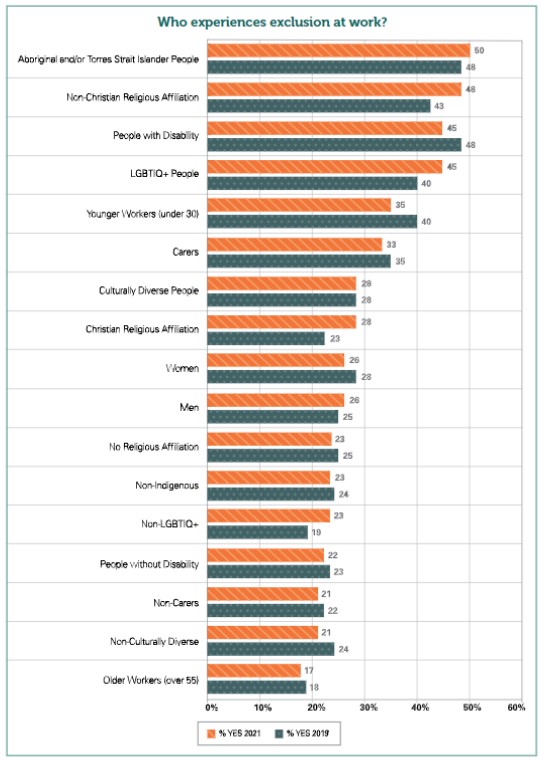OMA Diversity Survey 2023
The Outdoor Media Association (OMA) launched its first-ever OMA Diversity Survey 2023 from 22 February – 15 March 2023, for media-owning OMA members to investigate on how diverse the Australian Out of Home industry is and how we can contribute to a higher level of inclusion at work.
The survey contained 14 multiple-choice questions and took on average two minutes to complete. Responses to all the questions were mandatory. The OMA engaged a third party provider, Bendelta, to run this survey to ensure objectivity and confidentiality. All responses were anonymous.
We want an industry that reflects our nation, that develops talent and invests in people – regardless of age, culture, disability, gender, sexuality, nationality, and religion. Data from the Diversity Council Australia (DCA) found that employees working in inclusive teams are, for example:
10 times more likely to be satisfied.
11 times more likely to be highly effective.
four times less likely to leave their job in the next 12 months.
As the national peak body for the Australian Outdoor industry, we believe that diversity can fuel our growth.
“Our strengths lie in our differences. By investing in building more inclusive and diverse workplaces, we can ensure a brighter future.” (HRM online)1
Survey Response:
We had an overall response rate of 37.3%. The responses have provided an excellent understanding of the diversity of the Out of Home industry’s workforce, according to our survey developers Bendelta.
Diversity Census Results
Members can access the Census results HERE.
Please contact info@oma.org.au if you have any questions or need an OMA member login.
What’s Next:
The OMA diversity subcommittee is committed to serving and supporting the industry in becoming a more inclusive industry to work in.
Following the survey results, the OMA and the Diversity Sub Committee will:
- Review the OMA Diversity survey every two years.
- Provide policies and recommendations for our members to implement based on the survey data.
- Incorporate key D&I recommendations into the OMA Code of Ethics
Key Resources:
To assist our members in their own individual D&I journey the OMA has created the following resources to assist:
· Handy Resources Guide HERE
What is Diversity?
Diversity, in a corporate context, is the mix of people in an organisation. This includes all differences between people in how they identify in relation to their social identity (Aboriginal and/or Torres Strait Islander, age, culture, disability, gender, nationality, religion, and sexual orientation) and professional identity (education, experience, role).2
Cultural diversity, in a corporate context, is the mix of people in an organisation from different cultural backgrounds. This includes all differences in cultural and ethnic identity, such as: ancestry/heritage, colour of skin, country of birth, language, national origin, and race.
Cultural diversity can be measured by following key factors:

What is Inclusion?
Inclusion, in a corporate context, is getting this mix of people to work together. An inclusive work environment is an environment in which a diversity of people is
respected People at work feel valued and respected for who they are.
connected People at work feel connected to their colleagues and have a sense of belonging.
progressing People at work have opportunities to develop their careers and progress.
contributing People at work can contribute their skills to the organisational success.
Did you know?
30-70% | 300 | 27.6% |
| of Australian workers identify with more than one cultural background.2 | languages have been registered in the Australian Census 2016.3 | of Australia's population were born overseas in 2021.4 |
The DCA Inclusion@Work Index
The DCA Inclusion@Work Index tracks the state of inclusion in the Australian workforce, surveying a nationally representative sample of 3,000 Australian workers and investigating on two questions:
- How inclusive is the Australian workforce for a diversity of employees now, and how has it changed over time?
- What impact does inclusion have on employees’ performance and wellbeing?
In 2021, 27 per cent of all Australian workers still report having personally experienced or witnessed discrimination and/or harassment at work⁴.

The DCA Inclusion@Work Index 2021-2022 showed that workplace inclusion significantly increases professional performance and personal wellbeing5.
People working in inclusive teams are:
- 11 times more likely to be highly effective
- 10 times more likely to be innovative
- 10 times more likely to be satisfied
- 6 times more likely to provide excellent customer service
- 4 times more likely to work extra hard
- 4 times less likely to leave their job in the next 12 months
References
- HRM Online, Diversity and Inclusion: Response to Talent Underutilisation, 2023, accessed at: https://www.hrmonline.com.au/diversity-and-inclusion/hr-response-to-talent-underutilisation-australia/
- Diversity Council Australia/University of Sydney Business School (R. D’Almada- Remedios, D. Groutsis, A. Kaabel, and J. O’Leary) Counting Culture: Towards a Standardised Approach to Measuring and Reporting on Workforce Cultural Diversity in Australia, Sydney, Diversity Council Australia, 2021.
- Australian Bureau of Statistics, Census of Population and Housing: Reflecting Australia – Stories from the Census, 2017, accessed at: www.abs.gov.au.
- Australian Bureau of Statistics, Australia's Population by Country of Birth, 2021, accessed at: www.abs.gov.au/statistics/people/people-and-communities/cultural-diversity-census/2021.
- Diversity Council Australia (O’Leary, J. and D’Almada-Remedios, R.) DCA Inclusion@Work Index 2021-2022: Mapping the State of Inclusion in the Australian Workforce, Sydney, Diversity Council Australia, 2021.